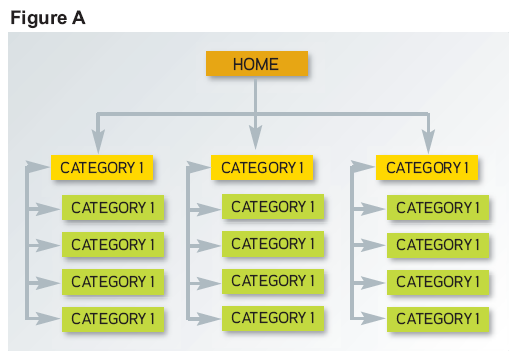Step-by-Step Search: Site Structure

In Part I of this Step-By-Step Search series, we took keyword research to the next level with Derek Vaughan and learned how to conduct comprehensive keyword research - a vital component to any search engine marketing campaign.
In this installment of the series, we will be learning from none other than Bruce Clay. With a laundry list of awards over the past 14 years, the name Bruce Clay has become synonymous with search engine optimization.
Part II - Site Structure
To understand why site structure (i.e. navigation and linking) is so important, we must understand Page Rank. Search algorithms place emphasis on the "authority" that a page or domain builds over time through linking - if other sites link to a particular site, this is a clear indication to the search engines of that site's importance. What's more, if several sites in a particular niche or industry link to another site, that is again a clear indication to search engines of that site's importance in that industry.
Getting relevant, incoming links is important. But what might even be more important is what you do with that authority once established.
Page rank flows like a river. Any page with authority can also impart authority - both to other sites and to other pages within the same website. By sculpting where it flows, we can concentrate that authority on particular pages; improving search traffic as a result.
Siloing and Theming
Several years ago, Bruce Clay of BruceClay.com developed a strategy known as "site siloing." The term comes from the grain silos you might see on a farm - they can be seen from far away and contain a single content (i.e. wheat grain, corn, etc). On your website, "silos" are groups of pages that contain similar, themed content. For example, if I have a website about cars, I might have a category called "sports cars" that would contain pages, articles and other content all related to sports cars. By collecting my content into themed silos, I can direct Page Rank and improve rankings due to the relationship between my pages. Site traffic can increase several times over just as a result of using the site siloing method properly.
So how exactly do you silo your website to improve site visibility with the search engines? According to Clay, "Keyword selection should be the start of the siloing process because you can align the right visitors with the right keywords, reduce bounce rate and increase conversions."
Since we've introduced the concept of theming, a word about how search engines see themes and related site content is in order. Latent Semantic Indexing (LSI) is an indexing method that identifies patterns in the relationships between terms and concepts. Words used within the same context (i.e. 'sports car' and 'Audi R8') have a relationship. Using that relationship, we can organize our keyword list into themes of related keywords. From those themes, our site structure begins to emerge.
There are tools to help derive keyword relationships; like Google's Wonderwheel, available on the left side of Google search results. Wonderwheel will show related keyword phrases that can be used to build subpages within each of your categories. As you build out related keywords based on their relationships, you will end up with many long-tail keyword phrases. Achieving rankings for one- or two-word queries (i.e. 'online dating', 'Web hosting', 'Blackberry') are important, but you really generate clicks and sales from three- to five-word queries (i.e. 'Jewish singles Washington DC').
Focusing on one keyword phrase per page gives search robots a strong indication toward the content of that page. Site owners, however, tend to want to rank for everything; and as a result, rank for nothing. Clay gives us a great example about how this tendency can harm, rather than help:
"I have a site that is all about white houses; I should rank well for white houses. But if I add a section for blue houses and 40 other colors, it dilutes the meaning of the site."
Targeting three- to five-word long-tail queries has its benefits. They are less competitive and easier to rank for as a result. Additionally, as a user gets further into the sales cycle, his queries become increasingly specific. For example, if shopping for a new car, I might start with "luxury sedan." As I get further along in my search and have a better understanding of what I want, I might search for "Mercedes CLS55." So, by targeting that long-tail keyword, the user can be captured deeper in the sales cycle when they are more likely to buy.
Let's take an example of a single category; Mercedes sedans. If I'm targeting the Mercedes line of sedans, I may come up with the keywords "Mercedes", "CLS", "S Class", "AMG", "SL500" and "CLS55 AMG". There is a hierarchy here, if you look closely. "Mercedes" would be my category or "silo landing page" and I could have sub-pages within this category; one for each of the terms "CLS", "S Class", "AMG", "SL500" and "CLS55 AMG". With this hierarchy, I'm ready to build my silo.
While directory structure is important for site usability, the search engines don't need it. More important is how we point our links and distribute page rank throughout the silo and the site as a whole. We want to keep related page rank (i.e. links relevant to our theme) within the theme. So, our subpages should link to the main silo landing page only. By doing this, we're driving authority and relevance to that main silo page, as seen in figure A.

Notice how the homepage only links to the main silo landing pages. As a result, page rank is focused on those pages only. Remember, if I have a page rank value of X for any given page, the collective page rank I'm passing to all of my pages is X. So, if I am linking to three pages, each page will receive one-third of that page rank. If I'm linking to 30 pages, each linked page receives a much smaller portion of that authority. Notice how the subpages only link to the main silo page. Page rank can flow anywhere. If I have in-bound links from another site to one of my subpages, any authority on that subpage gets passed to my main silo landing page. And, where authority goes rankings follow.
If you have pages that you need to link to but do not want to pass page rank to, you can use the no-index tag to keep the page you're linking to from being indexed and receiving that page rank:

This structure is a rule of thumb; if you have pages that you need to link to from a subpage for usability and conversions, don't feel constrained by this structure; but try to keep linking to unrelated pages at a minimum.
In the next part in our series on, we'll take the next step in our campaign and begin driving targeted backlinks to our website with the help of Rand Fishkin, co-founder of SEOMoz, a popular provider of SEO software.









